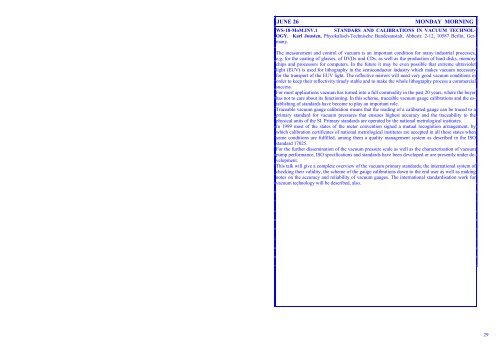Wüest M. 51 Wykes M. 82 Yamaguchi M. 17 Ybarra G. 129 Yubero F ...
Wüest M. 51 Wykes M. 82 Yamaguchi M. 17 Ybarra G. 129 Yubero F ...
Wüest M. 51 Wykes M. 82 Yamaguchi M. 17 Ybarra G. 129 Yubero F ...
Create successful ePaper yourself
Turn your PDF publications into a flip-book with our unique Google optimized e-Paper software.
JUNE 26 MONDAY MORNING<br />
WS-18-MoM.INV.1 STANDARS AND CALIBRATIONS IN VACUUM TECHNOL-<br />
OGY. Karl Jousten, Physikalisch-Technische Bundesanstalt, Abbestr. 2-12, 10587 Berlin, Germany.<br />
The measurement and control of vacuum is an important condition for many industrial processes,<br />
e.g. for the coating of glasses, of DVDs und CDs, as well as the production of hard disks, memory<br />
chips and processors for computers. In the future it may be even possible that extreme ultraviolet<br />
light (EUV) is used for lithography in the semiconductor industry which makes vacuum necessary<br />
for the transport of the EUV light. The reflective mirrors will need very good vacuum conditions in<br />
order to keep their reflectivity timely stable and to make the whole lithography process a commercial<br />
success.<br />
For most applications vacuum has turned into a full commodity in the past 20 years, where the buyer<br />
has not to care about its functioning. In this scheme, traceable vacuum gauge calibrations and the establishing<br />
of standards have become to play an important role.<br />
Traceable vacuum gauge calibration means that the reading of a calibrated gauge can be traced to a<br />
primary standard for vacuum pressures that ensures highest accuracy and the traceability to the<br />
physical units of the SI. Primary standards are operated by the national metrological institutes.<br />
In 1999 most of the states of the meter convention signed a mutual recognition arrangement, by<br />
which calibration certificates of national metrological institutes are accepted in all these states when<br />
some conditions are fulfilled, among them a quality management system as described in the ISO<br />
standard <strong>17</strong>025.<br />
For the further dissemination of the vacuum pressure scale as well as the characterisation of vacuum<br />
pump performance, ISO specifications and standards have been developed or are presently under development.<br />
This talk will give a complete overview of the vacuum primary standards, the international system of<br />
checking their validity, the scheme of the gauge calibrations down to the end user as well as making<br />
notes on the accuracy and reliability of vacuum gauges. The international standardisation work for<br />
vacuum technology will be described, also.<br />
29
















